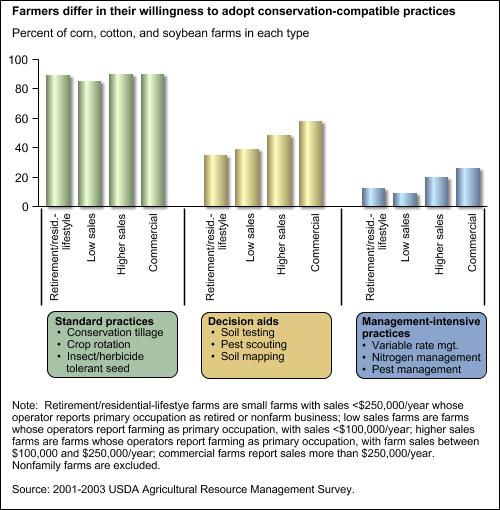Use of Conservation-Compatible Practices Varies by Farm Type
- by Dayton Lambert and Patrick Sullivan
- 2/1/2006
Farm operators have an incentive to adopt environmentally friendly farming practices that can increase their profits, but they may be reluctant to use costly practices that benefit the environment but do little to improve their bottom lines. For that reason, USDA offers payments to farmers based on their adoption of designated conservation practices. Not all farmers, however, are equally motivated by conservation program payments.
Operators of small farms and those who derive most of their income from off-farm occupations are less likely to adopt practices that require extra time or expense. Operators of larger operations and those who have college degrees, receive commodity program payments, or seek professional advice on management decisions are more likely to adopt the management-intensive practices.
Some farm management practices that benefit the environment onfarm and off-farm have been widely adopted: conservation tillage, crop rotation, and use of insect-resistant and herbicide-tolerant plants. These standard practices require relatively little from farmers in terms of new equipment or additional skill. Farms of all types use these practices to conserve resources, save time, and reduce labor and input costs without incurring sizeable conversion costs.
Adoption rates drop, however, with practices that require more management time or costly equipment upgrades. Farms that use decision aids (such as soil testing, pest scouting, and mapping) and more management-intensive practices (such as nutrient and pest management programs, and variable-rate input applications) must gather and process field-level information and use farming techniques that may be new. These practices have the potential to increase farm profits by optimizing the placement, application rate, and timing of fertilizers and pesticides, and they are more likely to be adopted by large farming operations than by smaller ones.
Nonfinancial motivations of farm operators may also help explain their tendencies to adopt conservation practices. For example, small farm operators heavily involved in off-farm activities may not have the time to devote to management-intensive practices.
These findings suggest that program incentives based solely on financial considerations may not be as effective or efficient as flexible incentive structures that recognize other farm operator goals.


